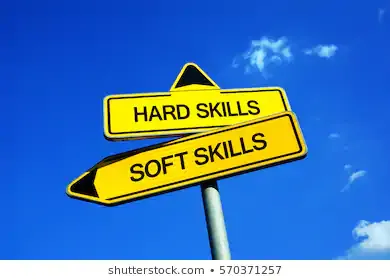The best things in life may be free, but that doesn't mean
you don't need to spend time, sweat, and perseverance to get them.
This is especially true when we are learning important life
skills.
To determine which skills are worth investing in, quora.
Once asked, "What are the most difficult and useful skills to learn?"
We have listed below the most recognized answers, as well as
some other skills that we consider important.
Hard skills examples:
01.
I once introduced the book "deliberate practice",
saying that as long as you master this method of deliberate practice, there
will be no skills you can't learn, and I still think so.
Although I don't have
any special skills and I haven't achieved remarkable results in my work, I'm
still sure that I don't have any skills I want to learn - but I can't!
I also said that all the people would return to their
families and have a comprehensive understanding. With more books, more
experience, and more attempts, we will naturally understand this truth. After
reading about 600 books, I suddenly came up with the exclamation of
"thousands of people return to their families, and they have a
comprehensive understanding".
In fact, most things in the world are not so
difficult to solve, and in a sense, most things in the world are essentially
the same. If you have achieved good results in one field, as long as you
carefully sum up the experience and lessons, and use them in other fields, I
believe you can also achieve good results.
In my opinion, learning a set of martial arts boxing is
exactly the same as singing a song, writing a word, drawing a picture, and
writing a novel. If you do any of them well, you will surely achieve the same
results when you learn other skills in the same way.
Now, for the above five
skills, let me take writing as an example to explain why they are essentially
the same. After reading them, you can believe what I said.
02
A calligraphy
The quality of a calligraphy work consists of five factors,
or five levels, which determine the quality of a calligraphy work.
(1) A stroke of every word. The most basic element of
calligraphy is a character, and the smallest element of every character is
stroke. Therefore, whether the characters are good-looking depends on whether
the strokes of the characters are good-looking. Only when the strokes that make
up the characters are written, can a word be written well.
So, if you want to learn calligraphy well, first of all, you
should write well. If you want to learn a certain type of font, you should
study the stroke characteristics of the font and write all the strokes in
place. Then the characters you write have the most basic characteristics of the
font in terms of shape. If you want to form your own style, you should study
and fix your own stroke characteristics.
(2) The structure of a word. When the strokes are finished, the
rule of putting them together is structure. For a specific font, its structure
is also different from other fonts, which is essentially the same as the
uniqueness of a certain font. To write a specific font, we need to study its
structure. Does it tend to be rectangular (imitating Song Dynasty) or flat, square and steady, or tight inside and loose outside, and flying? Different styles determine different fonts.
So to practice a font well, the second point is to study its
structure and then practice according to the structural characteristics of
this font. Then the written word is this specific font.
(3) Text layout
The so-called chapter layout of calligraphy is actually the
distance between characters, the distance between lines, the alignment of the
whole work, the blank space between the whole text and the edge of the paper,
etc. it is the relationship between each character of a calligraphy work in the
spaceplane. In general, the larger a single word is, the larger the gap
between words, lines, and lines, and between words and spaces in the whole text
is.
For alignment and whitespace, you need some design knowledge.
That is the application of alignment, contrast, and intimacy. Of course, it
also has something to do with the content of fonts and calligraphy works, which
should be determined by combining the content of calligraphy. This will be
discussed later.
If we want to learn the layout well, we need to study other
people's works and summarize the rules from them. There is also a need to learn
a little bit of graphic design knowledge and look at the PPT layout designed
by those very cattle people.
(4) Seal for signing
After the characters are written, they will be asked
questions. On the one hand, it is to indicate the author's name, write the
time, place, and other information. On the other hand, it is also a structural
supplement to calligraphy works. Because it is also an integral part of a work,
we should take it into consideration when we consider the layout of work.
In addition to the functions of angle stamp and name stamp, the seal can also make up for the lack of structure caused by the matching of font selection
and content. For example, if you write a "down" character, the
vertical one is very long, so that a large number of gaps are left on both
sides of it. At this time, you can use a small chapter to cover one of the
gaps, which can make up for a large number of gaps.
(5) Verve -- the correspondence between font and content
A good calligraphy work must be a work of God. A good
calligraphy work, not only every word to be good-looking, word to word, the line to
line distance to be comfortable, sign the chapter structure to be coordinated,
the most important thing is that the content reflected by the word to be
vividly reflected through the word.
To achieve this, we need to combine the font with the content
to be expressed, and the font should serve the content to be expressed. For
example, "the current is three thousand feet down, and it's suspected that
the Milky way is falling nine days." Such a poem is a bit awkward to
express with official script and seal script. It is a little solemn to express
with the regular script. Only running a script or cursive script can express its
momentum.
Therefore, if you are interested in calligraphy, you should
practice several types of fonts, starting with the most commonly used regular
script, running script, and official script. Until you have formed your own
style, you can be a teacher.
03
A painting
As for the advantages and disadvantages of a painting,
compared with calligraphy, we can also appreciate it from similar five factors,
or we can learn how to draw through similar five levels.
These five factors are as follows:
(1) Lines
(2) dyeing
(3) layout
(4) Signature for signature
04
A song
The key to singing a song well, compared with calligraphy and
painting is also composed of five factors, or five levels, which determine
whether you can sing a song well.
These five factors are as follows:
1. Whether every word (sound) is sung in place.
2. Whether each Lyric (melody) is sung in place.
3. Is the whole song complete from the beginning to the end?
4. Whether the expression and body language of singing are consistent with
the songs.
5. Whether you sing out the feelings expressed in the song, which
resonates with the audience.
05
A set of boxing
1. Play every basic action. The strength, speed, and accuracy are all in
place and the action is in line with the essentials.
2. Play every move well. The so-called move is also called
"walking". It consists of one to three basic movements, combining
body method and footwork. We should pay attention to the connection between the
basic actions and the basic actions, and pay attention to the speed in
sequence.
3. Make a good fist. We should pay attention to the connection between
moves, and pay attention to the speed in sequence.
4. The excessive moves focus on pause and coherence, the integrity from
the beginning to the end, from the beginning to the end, and also includes the situation in the actual combat (i.e. observe the surrounding environment before
the actual combat occupies a favorable terrain) and vigilance (keep alert after
the actual combat).
5. God in boxing. That is, eyes, spirit, and breath should be consistent
with the whole boxing. Speed, natural breathing, just right strength, high
spirits, eye to hand, highly concentrated spirit.
06
A novel
1. Words. Whether it's right to express what you want to express.
2. Sentences. Whether it's just right to express the content without much,
and further investigate the rhythmic beauty after expressing the meaning, so
that people can read it like a spring breeze, catchy and impressive, and it's
worth chanting repeatedly.
3. Plot. Whether the plot of the story is attractive, how to ambush, set
up suspense, and how to be brilliant.
4. Chapter structure and layout. What kind of structure, what kind of the narrative technique, etc.
5. The theme of the novel. What kind of characters are created, what
emotions and philosophies are expressed, what kind of inspiration and positive
energy is given to people.
To sum up, starting from the five components, taking
calligraphy as an example, this paper briefly introduces the basic components
of learning calligraphy, painting, singing, boxing routines, and a novel. Any
other skill or skill, in most cases.
If you want to master any of these skills, you can start from
the most basic factors, do special research and deliberate practice, then you can
certainly, achieve good results in this field, dare not say that you must become
a master in this field, but it is easy to let you stand out from the crowd and
be worth showing off.
As for how to persist in practice, accumulate more, achieve
goals in an easy way, and practice these skills, you can refer to my last article, "how can we make persistence a habit? " Of course, you don't
need to read my article, as long as you remember these four words: water drips
through stone!
As for the idiom "water drips through water", I
believe everyone knows it, but not everyone knows it? If you could use your own
words and experience to explain your understanding of these four words, what
would you say?
In my opinion, there are at least two meanings. One is
persistence, which you must have thought of, but do you know how to persist?
The best way, I think, is "micro habit + daily clock in". To put it
simply, set a goal that is small enough for you to accomplish immediately, and
make it your every drop of water.
Then punch in the card every day to achieve
this small goal. For example, writing 20 strokes or words every day (if you are
in a good mood, you can write more). Then clock in every day, and don't sleep
if you don't finish it.
Besides persistence, another meaning is regular repetition.
Did you think of that? Water drips through stone, that is to say, it drips
continuously. What about practicing calligraphy? That is, repeat every day,
practice one layer after another, until the formation of instinct.
In this way, I wish you success!






